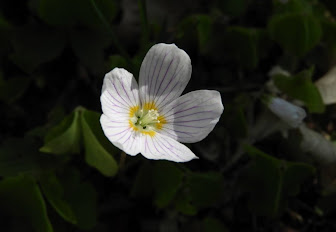Wood Sorrel, Oxalis acetosella is one of my favourite spring flowers and I can remember where I saw it for the first time in deciduous woodland above the River Wye near Tintern. One of its traditional names in Dorset, Somerset and Wales, and indeed Europe, is Alleluia as it appears around Easter time when Alleluia was sung in triumph in churches. Grigson links this with it being seen with delight. Certainly agree!
It likes shady, well drained humus-rich soils. It often grows through moss on fallen logs. There is a school of thought that it is a strong indicator of ancient woodland (I came across a reference to this in the book I'm reading at the moment Julian Hoffman's Irreplaceable - highly recommended by the way) though it is found in hedgerows and conifer plantations too.
The WildflowerFinder website (link below) is - not surprisingly- excellent on this plant. In subdued light the single flowers droop downwards and the trefoil leaves fold, pivoting about the fulcrum and folding along the mid-rib. I think that is happening here. The petals overlap.
In brighter conditions the flowers sit upright with both the petals and the trefoil leaves opened out. Even when the flowers are fully open the five petals are inwardly curved. The inner part of the petals have yellow markings which can be seen here along with the innermost sepal tube part being light green. There are five sepals, ten white stamens and five white styles with small stigmas.
The leaves have a sharp taste, and they were traditionally eaten as a spring salad, their sharpness taking the place of vinegar because they contain binoxalate of potash which is also present in rhubarb. In the early fifteenth century Wood Sorrel was cultivated in kitchen gardens. A sauce has been made of the leaves to be eaten with fish. Many of these traditions and recipes persist today in updated forms. It was used medicinally too but excess consumption was warned against especially for those with gout or rheumatism.
Both the botanical names refer to the acidity: oxalis: derived from Greek oxys meaning sour or acid and acetosella meaning vinegar salts.
Finally, some literary connections. Dorothy Wordsworth records in her Journal seeing it along with wood anemones, celandines, primroses, violets and daffodils. She and William were more entranced by the daffodils. Wrong move there? How about
I wandered lonely as a cloud ....when all at once I saw a host of white and mauve Fairy Bells; nodding, fluttering and dancing in the breeze.
Worth a second thought, William!
If you are having a busy day you might like to finish with another William, William Allingham, (1824-1889) an Irish poet, diarist and editor.
With Spring today!
Where copses tufted with primrose
Give me repose,
Wood-sorrel and wild violet
Soothe my soul's fret.
Acknowledgements
Grigson, An Englishman's Flora
Simon Harrap's Wildflowers
Irreplaceable, Julian Hoffman, published by Penguin
Websites include
https://wildflowerfinder.org.uk/
http://botanical.com/
http://www.seasonalwildflowers.com/
https://www.wildlifetrusts.org/wildlife-explorer/wildflowers/wood-sorrel
https://romantic-circles.org/editions/poets/texts/dorothyjournals.html
https://libquotes.com/william-allingham/quote/lbj9w0s




Thanks. Really interesting.
ReplyDelete